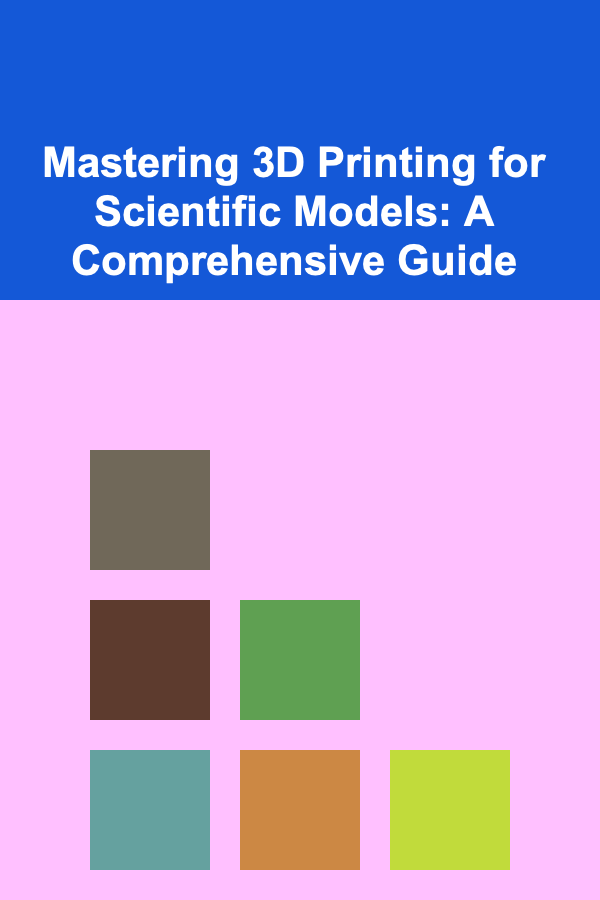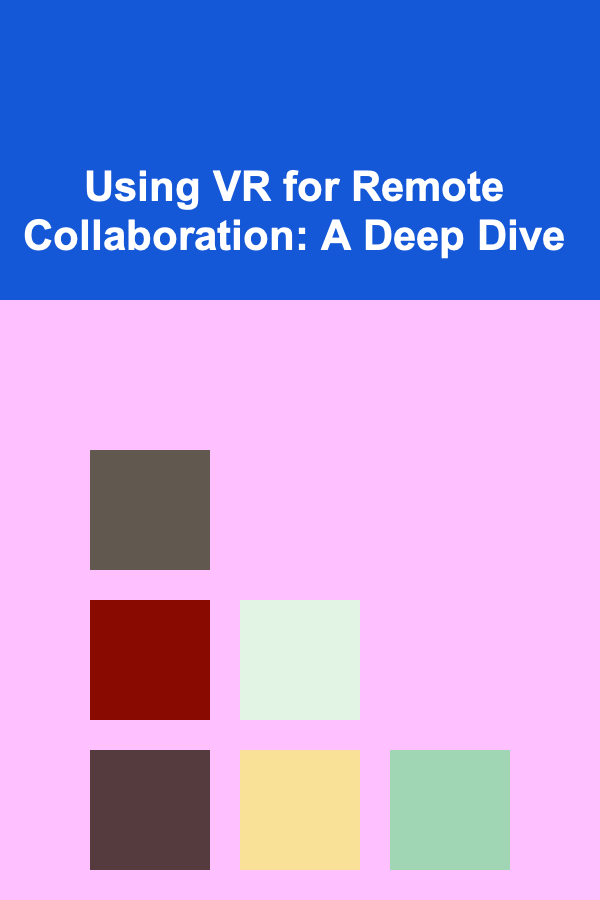
Mastering 3D Printing for Scientific Models: A Comprehensive Guide
ebook include PDF & Audio bundle (Micro Guide)
$12.99$9.99
Limited Time Offer! Order within the next:

3D printing, also known as additive manufacturing, has revolutionized numerous fields, and its impact on scientific modeling is particularly profound. By allowing researchers to create tangible, accurate representations of complex structures, 3D printing enhances understanding, facilitates collaboration, and accelerates the pace of scientific discovery. This comprehensive guide explores the intricacies of using 3D printing for scientific models, covering everything from selecting the right technology and materials to optimizing designs and post-processing techniques.
I. The Power of 3D Printing in Science
Traditional scientific modeling relies heavily on computer simulations, diagrams, and static physical models, each with its limitations. 3D printing overcomes many of these limitations by offering:
- Enhanced Visualization: Complex data, such as protein structures, geological formations, or anatomical models, can be visualized in three dimensions, providing a more intuitive understanding than a two-dimensional representation.
- Improved Communication: Physical models facilitate communication between researchers, students, and the public. They can be used to explain intricate concepts in a clear and engaging manner.
- Tangible Exploration: Unlike computer models, 3D printed models can be physically handled and examined from all angles, allowing for a more thorough exploration of their properties.
- Rapid Prototyping: Researchers can quickly create and test multiple iterations of a model, accelerating the design process and reducing development time.
- Customization and Precision: 3D printing allows for the creation of highly customized models with intricate details and precise dimensions, catering to specific research needs.
- Accessibility and Cost-Effectiveness: With the increasing affordability of 3D printers and materials, creating scientific models has become more accessible to researchers with limited budgets.
The applications of 3D printing in science are vast and diverse, spanning across various disciplines:
- Medicine: Creating patient-specific anatomical models for surgical planning, prosthetics, and medical device development.
- Biology: Modeling protein structures, DNA, and cellular components to study their function and interactions.
- Geology: Reconstructing fossil remains, visualizing geological formations, and creating educational models of the Earth's structure.
- Chemistry: Building molecular models for teaching and research purposes, visualizing complex chemical reactions.
- Engineering: Prototyping and testing new designs for mechanical components, structures, and devices.
- Archaeology: Replicating artifacts and archaeological sites for preservation and study.
- Astronomy: Visualizing celestial bodies and astronomical phenomena.
II. Choosing the Right 3D Printing Technology
Selecting the appropriate 3D printing technology is crucial for achieving the desired accuracy, material properties, and cost-effectiveness. Several technologies are commonly used for scientific modeling, each with its strengths and weaknesses:
A. Fused Deposition Modeling (FDM)
FDM is the most widely used 3D printing technology due to its affordability and ease of use. It involves extruding a thermoplastic filament through a heated nozzle and depositing it layer by layer onto a build platform. While FDM is suitable for creating basic models and prototypes, it typically produces parts with lower resolution and surface finish compared to other technologies.
Pros:
- Low cost
- Easy to use
- Wide range of materials available (PLA, ABS, PETG, etc.)
- Large build volumes available
Cons:
- Lower resolution and surface finish
- Layer lines visible
- Limited material options compared to other technologies
- Can require support structures that need to be removed
Suitable for: General visualization models, educational models, prototypes, and models where dimensional accuracy is not critical.
B. Stereolithography (SLA) and Digital Light Processing (DLP)
SLA and DLP are resin-based 3D printing technologies that use a light source (laser for SLA, projector for DLP) to selectively cure liquid resin layer by layer. These technologies produce parts with high resolution, smooth surface finish, and fine details, making them ideal for creating intricate scientific models.
Pros:
- High resolution and surface finish
- Excellent detail reproduction
- Wide range of resins available (standard, flexible, castable, etc.)
- Good dimensional accuracy
Cons:
- Higher cost than FDM
- Resin can be messy and require special handling
- Limited build volume compared to FDM
- Parts may require post-curing
- Some resins can be brittle
Suitable for: Detailed anatomical models, microfluidic devices, high-resolution prototypes, and models requiring smooth surfaces.
C. Selective Laser Sintering (SLS)
SLS is a powder-based 3D printing technology that uses a laser to selectively fuse powder particles together layer by layer. SLS can print with a variety of materials, including nylon, metal, and ceramics. It produces strong, durable parts with good dimensional accuracy and does not require support structures, making it suitable for creating complex geometries.
Pros:
- Strong and durable parts
- Good dimensional accuracy
- No support structures required
- Wide range of materials available (nylon, TPU, etc.)
- Complex geometries possible
Cons:
- High cost
- Rougher surface finish than SLA/DLP
- Limited color options
- Requires specialized equipment and expertise
Suitable for: Functional prototypes, end-use parts, complex geometries, and models requiring high strength and durability.
D. Multi Jet Fusion (MJF)
MJF is another powder-based technology that uses a fusing agent and a detailing agent to selectively fuse powder particles together. Similar to SLS, MJF produces strong, durable parts without the need for support structures. It offers excellent dimensional accuracy and isotropic properties, making it suitable for creating functional parts and complex assemblies.
Pros:
- Strong and durable parts
- Excellent dimensional accuracy
- Isotropic properties
- No support structures required
- Good surface finish
Cons:
- High cost
- Limited material options compared to SLS
- Requires specialized equipment and expertise
Suitable for: Functional prototypes, end-use parts, complex assemblies, and models requiring high strength, durability, and dimensional accuracy.
E. Metal 3D Printing (SLM, DMLS, EBM)
Selective Laser Melting (SLM), Direct Metal Laser Sintering (DMLS), and Electron Beam Melting (EBM) are metal 3D printing technologies used to create parts from metal powders. These technologies are capable of producing complex geometries with high strength and durability, making them suitable for aerospace, medical, and industrial applications. These processes are generally more complex and expensive than polymer printing technologies.
Pros:
- High strength and durability
- Complex geometries possible
- Wide range of metals available (titanium, aluminum, stainless steel, etc.)
Cons:
- Very high cost
- Requires specialized equipment and expertise
- Post-processing often required (heat treatment, machining)
- Limited build volume
Suitable for: Functional metal prototypes, end-use parts, complex geometries requiring high strength and durability, and applications in aerospace, medical, and industrial sectors.
III. Selecting the Right Material
The choice of material significantly impacts the mechanical properties, appearance, and functionality of the 3D printed model. Consider the following factors when selecting a material:
- Mechanical Properties: Strength, stiffness, flexibility, impact resistance, and thermal resistance.
- Accuracy and Resolution: Ability to reproduce fine details and maintain dimensional accuracy.
- Chemical Resistance: Resistance to solvents, acids, and other chemicals.
- Biocompatibility: Suitability for medical applications involving contact with living tissues.
- Appearance: Color, texture, and surface finish.
- Cost: Price per kilogram or liter.
- Ease of Printing: Printability and susceptibility to warping or other printing defects.
Here are some commonly used materials for scientific models:
- PLA (Polylactic Acid): A biodegradable thermoplastic derived from renewable resources. PLA is easy to print and produces good surface finish, but it is not very strong or heat resistant. Suitable for general visualization models and educational purposes.
- ABS (Acrylonitrile Butadiene Styrene): A strong and durable thermoplastic with good heat resistance. ABS is more challenging to print than PLA and requires a heated build platform to prevent warping. Suitable for functional prototypes and parts requiring higher strength.
- PETG (Polyethylene Terephthalate Glycol): A versatile thermoplastic with good strength, flexibility, and chemical resistance. PETG is easier to print than ABS and has better layer adhesion. Suitable for a wide range of applications, including functional prototypes, medical devices, and food-safe containers.
- Nylon (Polyamide): A strong and flexible thermoplastic with good abrasion resistance and chemical resistance. Nylon is hygroscopic, meaning it absorbs moisture from the air, which can affect its printability and mechanical properties. Suitable for functional prototypes, gears, and other parts requiring high strength and durability.
- TPU (Thermoplastic Polyurethane): A flexible and elastic thermoplastic with good abrasion resistance and tear strength. TPU is suitable for creating flexible parts, seals, and gaskets.
- Resins (Acrylic, Epoxy): Used in SLA and DLP printing, resins offer high resolution and smooth surface finish. Different types of resins are available with varying properties, including standard resins, flexible resins, castable resins, and biocompatible resins. Suitable for detailed models, microfluidic devices, and medical applications.
- Metals (Aluminum, Titanium, Stainless Steel): Used in SLM, DMLS, and EBM printing, metals offer high strength, durability, and heat resistance. Suitable for functional metal prototypes, end-use parts, and applications in aerospace, medical, and industrial sectors.
IV. Designing Models for 3D Printing
Designing models specifically for 3D printing requires careful consideration of the technology and material being used. Here are some key design considerations:
A. Geometry and Topology
- Overhangs: Avoid large overhangs that require extensive support structures. Design the model to be self-supporting whenever possible.
- Bridging: Minimize the length of bridges, which are horizontal spans between two supports. Long bridges can sag or collapse during printing.
- Wall Thickness: Ensure sufficient wall thickness to provide structural integrity. Thin walls can be fragile and prone to cracking.
- Internal Structures: Consider using infill patterns to reduce material usage and printing time. Choose an appropriate infill density based on the required strength and weight.
- Orientation: Orient the model on the build platform to minimize support structures and optimize surface finish. Consider the direction of layer lines and their impact on the model's appearance and mechanical properties.
B. Accuracy and Tolerances
- Dimensional Accuracy: Understand the limitations of the chosen 3D printing technology and material. Design the model with appropriate tolerances to ensure that parts fit together correctly.
- Feature Size: Ensure that small features are within the resolution capabilities of the 3D printer.
- Surface Finish: Consider the desired surface finish and choose a 3D printing technology and material that can achieve it. Post-processing techniques can be used to improve the surface finish further.
C. File Preparation
- STL Format: Export the 3D model as an STL file, which is the standard format for 3D printing.
- Mesh Resolution: Ensure that the STL file has sufficient mesh resolution to accurately represent the model's geometry. Too low resolution can result in faceted surfaces, while too high resolution can increase file size and processing time.
- Slicing: Use slicing software to convert the STL file into a set of instructions that the 3D printer can understand. The slicing software divides the model into layers and generates toolpaths for the printer's nozzle or laser.
- Slicing Parameters: Adjust slicing parameters, such as layer height, infill density, print speed, and temperature, to optimize print quality and printing time.
Several software tools are available for designing and preparing models for 3D printing:
- CAD Software: SolidWorks, Autodesk Inventor, Fusion 360, OpenSCAD (for parametric design).
- Mesh Editors: MeshLab, Blender (for modifying and repairing STL files).
- Slicing Software: Cura, Simplify3D, PrusaSlicer.
V. Optimizing the 3D Printing Process
Achieving high-quality 3D prints requires careful attention to the printing process. Here are some tips for optimizing the printing process:
- Calibration: Calibrate the 3D printer regularly to ensure accurate printing. This includes leveling the build platform, adjusting the Z-offset, and calibrating the extruder.
- Temperature Control: Maintain proper temperature control of the extruder, build platform, and surrounding environment. Different materials require different temperature settings.
- Print Speed: Adjust the print speed to optimize print quality and printing time. Slower print speeds generally result in better surface finish and accuracy, but they also increase printing time.
- Layer Height: Choose an appropriate layer height based on the desired resolution and printing time. Lower layer heights result in better resolution but also increase printing time.
- Adhesion: Ensure good adhesion between the first layer and the build platform. Use adhesion aids, such as glue stick, hairspray, or blue tape, to improve adhesion.
- Support Structures: Use support structures to support overhangs and bridges. Optimize the support structure placement and density to minimize material usage and printing time.
- Environmental Control: Control the temperature and humidity of the printing environment. Some materials are sensitive to temperature and humidity fluctuations.
VI. Post-Processing Techniques
Post-processing techniques are often necessary to improve the appearance, functionality, and mechanical properties of 3D printed models. Here are some common post-processing techniques:
- Support Removal: Remove support structures using pliers, knives, or solvents. Be careful not to damage the model during support removal.
- Sanding: Sand the surface of the model to remove layer lines and smooth out imperfections. Use progressively finer grits of sandpaper to achieve a smooth finish.
- Filling: Fill gaps and imperfections with filler or epoxy. Sand the filler smooth after it has dried.
- Painting: Paint the model to add color and improve its appearance. Use appropriate paints and primers for the chosen material.
- Polishing: Polish the model to create a glossy finish. Use polishing compounds and cloths to achieve a smooth and shiny surface.
- Coating: Apply a coating to protect the model from wear, chemicals, or UV radiation. Coatings can also improve the model's appearance and functionality.
- Vapor Smoothing: Expose the model to solvent vapor to smooth out the surface. This technique is commonly used for ABS parts.
- Heat Treatment: Heat treat metal parts to improve their strength and durability.
- Machining: Machine the model to achieve precise dimensions and tolerances.
VII. Case Studies: 3D Printing in Action
Here are some examples of how 3D printing is being used in various scientific fields:
A. Medical Modeling: Surgical Planning
3D printed anatomical models are increasingly used for surgical planning. Surgeons can use these models to visualize complex anatomical structures, practice surgical procedures, and determine the best approach for surgery. Patient-specific models can be created from CT or MRI scans, allowing surgeons to tailor the surgery to the individual patient's anatomy. This can lead to improved surgical outcomes, reduced operating time, and fewer complications.
B. Biological Modeling: Protein Structures
3D printing is used to create tangible models of protein structures. These models can help researchers to understand the function of proteins and to design new drugs that target specific proteins. 3D printed protein models can also be used for educational purposes, allowing students to visualize complex molecular structures.
C. Geological Modeling: Fossil Reconstructions
3D printing is used to reconstruct fossil remains. Damaged or incomplete fossils can be scanned and 3D printed, allowing researchers to study them in detail without risking further damage to the original fossils. 3D printed fossil replicas can also be used for educational purposes and museum exhibits.
D. Engineering Modeling: Rapid Prototyping
Engineers use 3D printing for rapid prototyping of new designs. 3D printing allows engineers to quickly create and test multiple iterations of a design, accelerating the development process and reducing costs. 3D printed prototypes can be used to evaluate the form, fit, and function of a design before it is manufactured on a larger scale.
VIII. The Future of 3D Printing in Science
The field of 3D printing is rapidly evolving, with new technologies and materials being developed all the time. The future of 3D printing in science is bright, with the potential to revolutionize research, education, and healthcare. Some emerging trends include:
- Bioprinting: 3D printing of living tissues and organs. Bioprinting has the potential to revolutionize medicine by creating replacement organs for transplantation.
- Multi-Material Printing: 3D printing of parts with multiple materials. This allows for the creation of parts with varying properties and functionalities.
- 4D Printing: 3D printing of objects that can change their shape or properties over time in response to stimuli such as heat, light, or water.
- Artificial Intelligence (AI) Integration: Using AI to optimize the 3D printing process, predict print failures, and automate design and manufacturing.
- Increased Accessibility and Affordability: Continued decrease in the cost of 3D printers and materials, making the technology more accessible to researchers and educators.
As 3D printing technology continues to advance, its impact on science will only grow stronger. By mastering the techniques and principles outlined in this guide, researchers can unlock the full potential of 3D printing and accelerate the pace of scientific discovery.
IX. Conclusion
3D printing has emerged as a powerful tool for scientific modeling, offering unique capabilities for visualization, communication, and rapid prototyping. By carefully selecting the appropriate technology and materials, optimizing designs, and mastering post-processing techniques, researchers can create accurate, functional, and visually compelling models that enhance understanding and accelerate scientific advancements. As the technology continues to evolve, 3D printing will undoubtedly play an increasingly vital role in shaping the future of scientific exploration and innovation.

How to Maximize Small Spaces with Vertical Shelving Systems
Read More
How to Reduce Sodium Intake for Better Health
Read More
How To Choose the Best Supernatural Fiction
Read More
Using VR for Remote Collaboration: A Deep Dive
Read More
Understanding the Driving Experience of EVs: A Deep Dive
Read More
How to Photograph Astrophotography with a Smartphone
Read MoreOther Products

How to Maximize Small Spaces with Vertical Shelving Systems
Read More
How to Reduce Sodium Intake for Better Health
Read More
How To Choose the Best Supernatural Fiction
Read More
Using VR for Remote Collaboration: A Deep Dive
Read More
Understanding the Driving Experience of EVs: A Deep Dive
Read More